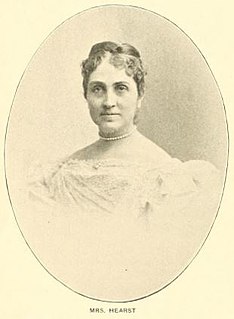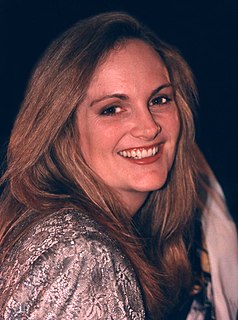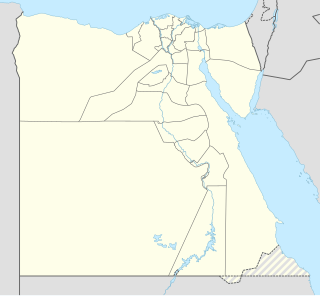
The Nile is a major north-flowing river in northeastern Africa, and is the longest river in Africa and in the world, though some sources cite the Amazon River as the longest. The Nile, which is about 6,650 km (4,130 mi) long, is an "international" river as its drainage basin covers eleven countries, namely, Tanzania, Uganda, Rwanda, Burundi, the Democratic Republic of the Congo, Kenya, Ethiopia, Eritrea, South Sudan, Republic of the Sudan and Egypt. In particular, the Nile is the primary water source of Egypt and Sudan.

Phoebe Elizabeth Apperson Hearst was an American philanthropist, feminist and suffragist. She was the mother of William Randolph Hearst and wife of George Hearst.

William Randolph Hearst Sr. was an American businessman, newspaper publisher, and politician known for developing the nation's largest newspaper chain and media company, Hearst Communications. His flamboyant methods of yellow journalism influenced the nation's popular media by emphasizing sensationalism and human interest stories. Hearst entered the publishing business in 1887 with Mitchell Trubitt after being given control of The San Francisco Examiner by his wealthy father.

Patricia Campbell Hearst is the granddaughter of American publishing magnate William Randolph Hearst. She became internationally known for events following her 1974 kidnapping and physical violation by a domestic American terrorist group calling itself the Symbionese Liberation Army. Hearst was found 19 months after being abducted, by which time she was a fugitive wanted for serious crimes. She was held in custody, despite speculation that her family's resources would prevent her from spending time in jail. At her trial, the prosecution suggested that she had joined the Symbionese Liberation Army of her own volition, a claim that conflicted with Hearst's own account that she had been raped and threatened with death. In 1976, she was convicted for the crime of bank robbery and sentenced to 35 years in prison, later reduced to 7 years. Her sentence was commuted by President Jimmy Carter and she was later pardoned by President Bill Clinton.

Egyptology is the study of ancient Egyptian history, language, literature, religion, architecture and art from the 5th millennium BC until the end of its native religious practices in the 4th century AD. A practitioner of the discipline is an "Egyptologist". In Europe, particularly on the Continent, Egyptology is primarily regarded as being a philological discipline, while in North America it is often regarded as a branch of archaeology.

Hearst Castle, San Simeon, is a National Historic Landmark and California Historical Landmark located on the Central Coast of California in the United States. The joint concept of William Randolph Hearst, the publishing tycoon, and his architect Julia Morgan, it was built between 1919 and 1947. Known formally as "La Cuesta Encantada",, and often referred to simply as San Simeon, Hearst himself called his castle, the "Ranch". His father George Hearst had purchased the original 40,000 acre estate in 1865 and Camp Hill, the site for the future Hearst Castle, was used for family camping holidays during Hearst's youth. Following his mother's death in 1919 Hearst inherited some $11,000,000 and estates including the land at San Simeon. Hearst used his fortune to further develop his media empire of newspapers, magazines and radio stations, the profits from which supported a lifetime of building and collecting. Within a few months of Phoebe Hearst's demise, Hearst had commissioned Julia Morgan to build "something a little more comfortable up on the hill", the genesis of the present castle. Morgan was an architectural pioneer; "America's first truly independent female architect", she was the first woman to study architecture at the School of Beaux-Arts in Paris, the first to have her own architectural practice in California and the first female winner of the American Institute of Architects Gold Medal. Working in close collaboration with Hearst for over twenty years, the castle at San Simeon is her most renowned creation.

The Twelfth Dynasty of ancient Egypt, is often combined with the Eleventh, Thirteenth and Fourteenth Dynasties under the group title Middle Kingdom.
The Fifth Dynasty of ancient Egypt is often combined with Dynasties III, IV and VI under the group title the Old Kingdom. The Fifth Dynasty pharaohs reigned for approximately 150 years, from the early 25th century BC until the mid 24th century BC.

George Andrew Reisner was an American archaeologist of Ancient Egypt, Nubia and Palestine.

The Institut français d'archéologie orientale, also known as the French Institute for Oriental Archaeology in Cairo is a French research institute based in Cairo, Egypt, dedicated to the study of the archaeology, history and languages of the various periods of Egypt's civilisation.

Djedhor, better known as Teos or Tachos, was an ancient Egyptian pharaoh of the 30th Dynasty.

The Lepsius list of pyramids is a list of sixty-seven Ancient Egyptian pyramids established in 1842–1843 by Karl Richard Lepsius (1810–1884), an Egyptologist and leader of the "Prussian expedition to Egypt" from 1842 until 1846.

Egyptian medical papyri are ancient Egyptian texts written on papyrus which permit a glimpse at medical procedures and practices in ancient Egypt. The papyri give details on disease, diagnosis, and remedies of disease, which include herbal remedies, surgery, and magical spells. It is thought there were more medical papyri, but many have been lost due to grave robbing. The largest study of the medical papyri to date has been undertaken by Berlin University and was titled Medizin der alten Ägypter.

The Hearst Papyrus, also called the Hearst Medical Papyrus, is one of the medical papyri of ancient Egypt. It was named after Phoebe Hearst. The papyrus contains 18 pages of medical prescriptions written in hieratic Egyptian writing, concentrating on treatments for problems dealing with the urinary system, blood, hair, and bites. It is dated to the first half of the 2nd millennium BC. It is considered an important manuscript, but some doubts persist about its authenticity.

The Land of Punt was an ancient kingdom. A trading partner of Egypt, it was known for producing and exporting gold, aromatic resins, blackwood, ebony, ivory, and wild animals. The region is known from ancient Egyptian records of trade expeditions to it. It is possible that it corresponds to Opone as later known by the ancient Greeks, while some biblical scholars have identified it with the biblical land of Put or Havilah.

Karl or Carl Richard Lepsius was a pioneering Prussian Egyptologist and linguist and pioneer of modern archaeology.

Hadım Suleiman Pasha was an Ottoman statesman and military commander. He was the (viceroy) of Ottoman Egypt in 1525–1535 and 1537–1538, and Grand Vizier of the Ottoman Empire between 1541 and 1544. He was a Hungarian eunuch, his epithet hadım meaning "eunuch" in Turkish.
Walter Wreszinski was a German Egyptologist and professor at Albertus University of Königsberg.
Deir el-Ballas is an archaeological site in Upper Egypt. It was the location of a royal palace and administration center occupied by rulers of the Seventeenth Dynasty in ancient Egypt's late Second Intermediate Period.


















